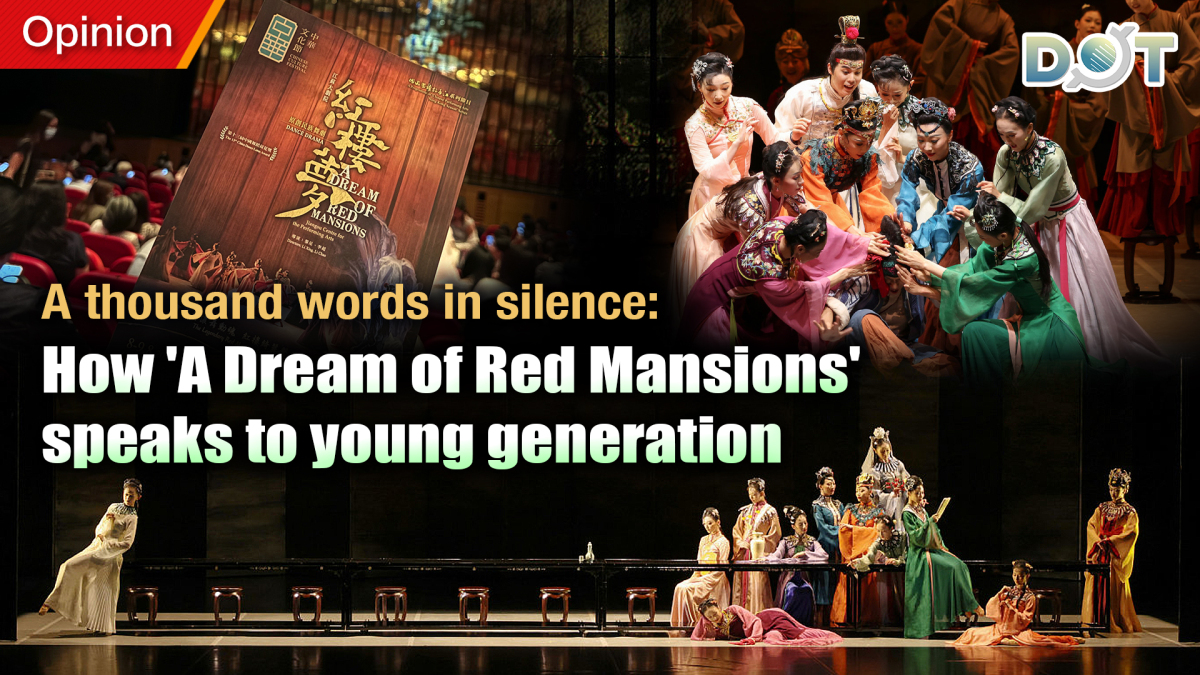
By Zoey SUN
"A Dream of Red Mansions" (紅樓夢) is a towering masterpiece of Chinese classical literature; the Lotus Award, a dazzling crown of Chinese dance artistry. When the original ethnic dance drama "A Dream of Red Mansions", produced by Jiangsu Centre for the Performing Arts, won the 13th Lotus Award and took the stage at the Hong Kong Cultural Centre from Aug. 8–10, 2025, the theater was packed to capacity. Even seats with obstructed views were filled with eager spectators, many of them young faces.

I was fortunate to secure a center-front seat. As the lights dimmed, my mind drifted back to my school days, first reading "A Dream of Red Mansions." Back then, it was merely a textbook excerpt, a mandatory "task" to memorize for exams—a bitter pill to swallow. Yet now, seated in the theater, I found myself grateful for those reluctant encounters with the classic. Though I couldn't recall every detail of the novel, it was enough to follow the dancers' rhythms and savor the depth of their gestures.

About thirty minutes before the performance began, a unique "dream-entering" ritual unfolded. A long table stood onstage, with an empty vase at its center. Accompanied by melodious music and the solemn tolling of bells, the Twelve Beauties of Jinling (金陵十二釵) appeared one by one. Each placed a flower in the vase or on the table in her own unique way before fading into the background. This 2-hour-and-20-minute dance drama condensed the novel's most iconic chapters into twelve acts, including "Entry" (入府), "Imperial Visitation" (省親), "Burial of Flowers" (葬花), "Lantern Festival" (元宵), and "Warding-off Evil" (沖喜). Each act stood alone yet was intricately interwoven, progressing layer by layer with a tightly knit narrative.

As the glass curtain rose and the stage was unveiled, the dancers used nothing but the power of their bodies and the fullness of their emotions to bring to life the tragic fates of the Twelve Beauties and the tangled love triangle of Baoyu, Daiyu, and Baochai.
Throughout the entire performance, there was not a single spoken word. Yet as the story unfolded, lines from the novel surfaced unbidden in my mind. During "Entry," Wang Xifeng's flamboyant entrance instantly evoked her famous line, "I'm late in greeting our guest from afar! (王熙鳳:我來遲了,不曾迎接遠客!)" When Baoyu and Daiyu first locked eyes, the moment of their mutual recognition—bathed in white light and frozen in time—brought to mind their fateful remarks: "How very strange! It's as if I'd seen him somewhere before. He looks so familiar. (林黛玉:好生奇怪,倒像在那裹見過一般,何等眼熟到如此!)" and "I've met this cousin before. (賈寶玉:這個妹妹我曾見過的。)" In "Covetous Whispers" (含酸), as Daiyu approached Baoyu and Baochai laughing together, the subtle ripples of emotion in her eyes and the turmoil in her heart as she sat down seemed to echo the line: "If he hadn't appeared, I would enjoy my being here. (林黛玉:早知他來,我就不來了。)" Though the dance was silent, it spoke volumes.
The stage design was a direct blow to the soul. In "Imperial Visitation", Yuanchun, cloaked in a yellow robe, moved lifelessly among a troupe of puppets dressed in somber blue official attire, her stiff, mechanical movements reflecting her inner emptiness. Only when she shed the yellow robe—a symbol of her imprisonment—did she come alive, playing joyfully with her siblings, her laughter radiant. As the scene ended, the family knelt before the now-empty yellow robe at the center of the stage. The crushing weight of the feudal hierarchy, its absurdity and cruelty, was conveyed without a single word.

In "Warding-off Evil", the visual clash of red and white was both breathtaking and harrowing. Beneath the celebratory red attire, white water sleeves lashed out like ghostly banners, encircling Daiyu in her pale mourning robes as she burned her manuscripts and succumbed to illness. The violent collision of red and white, life and death, laid bare the suffocation of marriage and the agony of a fading life.
In the finale, Baoyu gently lifted the curtain, revealing the Twelve Beauties in their resplendent costumes. As he gazed back, it felt as though he were reflecting on his entire life. The Twelve Beauties walked toward him, yet they passed each other by, leaving behind only a field of white flowers—pure and mournful.
One particularly poignant moment was the "Family Reunion (團圓)" scene, which, despite the story's inherent tragedy, offered a touch of warmth. By this point, the Beauties had long perished, yet their figures reappeared behind a thin veil, as if still frolicking in the garden. Though separated by a single curtain, the divide between reality and illusion was insurmountable.

This fleeting vision, though nothing more than Baoyu's (or the creator's) "moon in the water," conveyed an aching tenderness amidst the overwhelming sorrow. As director of the dance drama, Li Xing, explained, "Whether it's Mr. Cao Xueqin, Baoyu, or myself as the performer, we all feel that these girls are too beautiful and wonderful to be lost. The novel reveals their genuine affection for Baoyu, and on stage, when they smile at me, I can see the 'water-like' tenderness Mr. Cao spoke of. Even if it's just an illusion, I want to give them a moment of reunion through my art."
As the audience left, many were visibly moved, and I overheard some discussing how they had traveled across cities to see different cast combinations. According to the Jiangsu Centre for the Performing Arts, the average age of the audience for "A Dream of Red Mansions" dance drama is around 27. The dance drama has also become a "must-watch" performance recommended widely online, particularly by young viewers.
Why has this centuries-old classic struck such a deep chord with the younger generation in today's fast-paced, information-saturated world?

The answer lies in the art form itself. This young generation thrives in a visual culture. The dance drama dispenses with lengthy textual exposition, replacing it with stunning visual imagery that speaks directly to the heart—whether it's the eerie solemnity of the yellow-robed puppets, the violent clash of red and white, or the poignant beauty of a stage strewn with white flowers. These powerful, symbolic visuals transcend the barriers of language, conveying profound emotions and universal themes. The dancers' every glance, turn, and tremor externalized the shared human experiences of love, jealousy, and sorrow, eliciting an instinctive emotional response.
Moreover, the twelve-act structure, inspired by theater concepts that break free from linear storytelling, is fast-paced and immersive, aligning with young people's preference for efficient narratives and engaging experiences. Director Li Xing's modern perspective, such as the inclusion of the "Family Reunion" scene, imbues the ancient tale with fresh relevance, resonating with contemporary sensibilities. The high production quality, the communal thrill of live theater, and even the "fandom" culture of chasing favorite performers all contribute to making this dance drama a deeply participatory and shareable cultural experience.
Social media platforms like Xiaohongshu and Douyin have further amplified the drama's appeal among young audiences. Beyond those who are inherently drawn to literary classics, many young audiences may have first encountered "A Dream of Red Mansions" through short video clips circulating on social media platforms-Baoyu passes by Daiyu and Baochai, followed by Baoyu's wistful glance, set against music that perfectly complements the scene's emotional depth. These moments ignite their desire to experience the performance in person.
However, the dance drama carries a certain threshold for appreciation. Its condensed imagery and narrative require a basic familiarity with the original story. This prompts many young viewers, after purchasing tickets or before attending the show, to actively seek out resources on social media—breakdowns of key scenes, character relationships, or even "viewing guides"—to quickly "fill in the gaps." Once seated in the theater, they are overwhelmed by the silent yet monumental storytelling and visual impact, sparking deeper curiosity about specific scenes or characters' fates. This curiosity leads them back to social platforms, where they search for more in-depth analyses, reviews, and even behind-the-scenes stories.
This cycle—from initial visual allure (short videos) → knowledge acquisition (searching) → live experience (theater) → deeper exploration (further searching) → eventual return to the original novel—forms a unique cultural consumption loop. At its core, however, lies the exceptional artistic quality of the dance drama itself. Its ability to captivate and retain young audiences at every stage is what makes this cycle of exploration and rediscovery possible.
Besides, these platforms also foster communities where fans exchange ticket-buying strategies, analyze symbolic meanings, and even create fan art or journals inspired by the performance, further extending its influence.
In its silence, the dance drama echoes thunderously. When the centuries-old dream of the Red Mansion takes to the modern stage, it transcends the confines of textbooks and becomes a visual and emotional storm that sweeps into the hearts of a younger generation. It proves that the power of a classic lies in its timeless emotional core—once paired with the right artistic medium, such as this wordless yet resounding dance, it can resonate across eras and ignite the most fervent responses in every age.
As the curtain falls, the audience left with a strong urge to revisit "A Dream of Red Mansions" on their bookshelves. And perhaps, therein lies the ultimate triumph of this dance drama.
(Video source: Zoey SUN)




















Comment